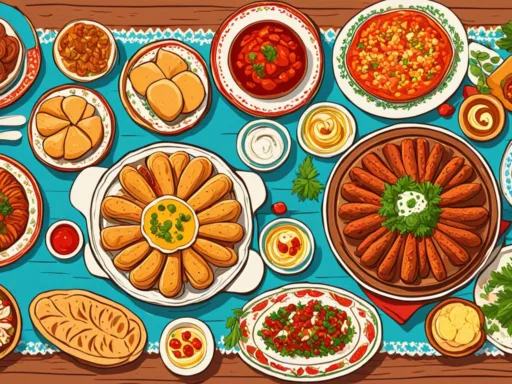Did you know that Haitian cuisine is one of the world’s best-kept culinary secrets, with a heritage dating back centuries? Embarking on a Haitian culinary journey opens a repertoire of flavors that fuse African, Taíno, and European influences into a singular gastronomic experience. To truly appreciate this under-explored cuisine, it’s essential to dive into the colorful tapestry of traditional Haitian recipes and share the taste of Haiti with a global audience. Let’s unveil the culinary delights that form the cornerstone of Haitian cuisine, offering more than just sustenance but a celebration of culture with every bite of authentic Haitian dishes.
Key Takeaways
- Discover the hidden treasures of Haitian food culture and its historical roots.
- Experience the rich flavors of traditional Haitian cuisine through iconic dishes.
- Learn about the community impact of meals in Haiti’s vibrant food scene.
- Explore the variety of Haitian cooking techniques and locally sourced ingredients.
- Find inspiration to recreate authentic Haitian dishes in your own kitchen.
- Connect with Haitian heritage through a deep dive into regional dishes and preparations.
The Intriguing Story of Haitian Food Culture
Within the Caribbean basin lies a culinary treasure that remains somewhat unexplored by the world at large—Haitian food culture. This cuisine embodies a remarkable synthesis of flavors and traditions that beckon food enthusiasts to delve deeper into its history and offerings. Steeped in a rich narrative, Haitian gastronomy invites a sense of discovery, as every dish tells a story more vibrant than the last, sounding a call to savor the delicious Haitian flavors.
A Land of Flavors: Haitian Cuisine Fundamentals
Haitian cuisine is an artful blend of its lush landscape and historical elements. It is a cuisine that hinges on staple ingredients like rice, beans, and maize, enhanced with a kaleidoscope of herbs and spices that create the foundation for many traditional Haitian recipes. The essence of exploring Haitian gastronomy can be found in the simplicity of its methods conjoined with the complexity of its flavor profiles, producing meals that are both nutritious and evocative of the land’s generous bounty.
The Melting Pot: Historical Influences on Haitian Gastronomy
The culinary heritage of Haiti celebrates a diversity born from the confluence of various cultures. African, Taino, and European cuisines have melted into a unique gastronomic identity where one can trace the lineage of delicious Haitian flavors throughout history. This fusion translates into dishes that have absorbed influences originating from remote continents, marrying them into something wholly Haitian yet eclectically worldly.
Community and Cuisine: How Meals Bring Haitians Together
The notion of community in Haiti transcends beyond geographical boundaries, taking shape around dining tables throughout the country. In Haiti, meals are a communal affair; they’re a special time for sharing, laughter, and reinforcing social bonds. Traditional Haitian recipes are often passed down through generations, embodying the spirit of togetherness and shared heritage that is central to the Haitian way of life, especially during gatherings that celebrate life’s milestones.
| Ingredient | Significance | Typical Dish |
|---|---|---|
| Rice (Diri) | Staple of diet; represents sustenance | Diri ak Pwa (Rice and Beans) |
| Plantains (Bannann) | Symbol of versatility in Haitian cooking | Peze ak Sos Pwa (Fried Plantains with Bean Sauce) |
| Pork (Griot) | Reflects the Creole influence and festive occasions | Griot with Pikliz |
| Spices (Epis) | Heart of flavor; epitomizes Haitian culinary flair | Marinades for meats, sauces, and stews |
Embarking on a Haitian Culinary Journey
The vibrant flavors of Haiti are making a resounding echo across culinary landscapes, and at the heart of this renaissance is the Haitian Cuisine Takeover (HCT). At the helm is Valery, a seasoned chef with over a decade and a half of experience, who has taken it upon himself to redefine the narrative of Haiti’s gastronomic identity in the United States.

Through HCT, Valery has vowed to showcase the culinary delights of Haiti and share them with an international audience eager for authentic cuisine. His strategy weaves together delectable food tours, interactive workshops, and educational initiatives to broaden understanding and appreciation of Haitian food culture. This mission is more than just food; it’s a cultural crusade to highlight the deep-seated traditions and unwavering community spirit that is intrinsically linked to the Haitian culinary journey.
Each event curated by the HCT team is a multi-sensory immersion into the heart of Haiti’s cuisine. Patrons are not only spectators but become active participants, learning about the significance of each dish and the stories behind Haiti’s flavorful tapestry – a narrative punctuated by vibrant spices, compelling textures, and a harmony of influences that span centuries.
From street-side vendors to family kitchens, the HCT experience unravels the complex layers of flavors embedded in Haitian heritage, establishing a connection that transcends mere taste and fostering a community among those who partake in this journey.
Valery’s passion for his homeland’s cuisine is palpable, and through Haitian Cuisine Takeover, the world is invited to partake in a Haitian culinary journey – to savor, to learn, and to embrace the spirited community connected by the love of Haitian cuisine.
- Haitian food tours across the U.S. that map the historical and cultural footprint of Haiti’s gastronomy.
- Interactive cooking workshops designed to teach the secrets of traditional Haitian recipes.
- Engaging educational initiatives that aim to share the narrative of Haiti’s culinary heritage with a broader audience.
- Specially crafted events that communicate the dynamic essence and culinary delights of Haiti.
So, step up to the plate and join the Haitian Cuisine Takeover, for it promises to be a journey where the vibrant flavors of Haiti are not just tasted but intimately experienced, savored, and cherished.
Haitian Cuisine’s Signature Dishes and Ingredients
When it comes to the rich tapestry of Caribbean flavors, Haitian cuisine stands out with its unique blend of textures and seasonings. The gastronomic landscape of Haiti is studded with authentic Haitian dishes that tell a story of history, culture, and community. From the succulent Griot to the heartwarming Joumou Soup, each traditional Haitian recipe is a testament to the nation’s culinary ingenuity and heritage.
Griot and Pikliz: An Unbeatable Duo
Griot, a beloved Haitian classic, is renowned for its mouthwatering marinade and crispy fried exterior. Typically made from pork that is seasoned, boiled, and then fried, Griot presents a beautiful symphony of flavors, especially when complemented by Pikliz—a fiery pickled vegetable medley. This iconic pair exemplifies the bold, vibrant spirit of Haitian gastronomy.
Joumou Soup: The Taste of Freedom and Celebration
The golden-hued Joumou Soup is not only a culinary delight but also a symbol of triumph and freedom. This hearty pumpkin-based soup brims with a variety of root vegetables, meat, and spices. Consumed universally on Haitian Independence Day, Joumou Soup represents an edible narration of Haiti’s struggle and victory against colonial forces, uniting Haitians in a warm, celebratory tradition.
Pate: The Haitian Answer to Empanadas
The flaky and versatile Haitian pate is a pastry-lover’s dream come true. Often filled with either spiced meat or a blend of savory vegetables, these turnovers are the Haitian response to the Latin American empanada, showcasing the multicultural influences that have shaped Haiti’s palate. Whether enjoyed as a snack or a substantial part of a meal, the pate embodies the fusion of tastes that distinguish Haitian cuisine.

| Dish | Main Ingredients | Significance |
|---|---|---|
| Griot | Pork shoulder, orange juice, garlic, scotch bonnet pepper | A staple of Haitian celebratory feasts |
| Pikliz | Cabbage, carrot, vinegar, hot pepper | A spicy condiment that cuts through the richness of Haitian dishes |
| Joumou Soup | Pumpkin, beef, potatoes, pasta | A symbol of independence, served on New Year’s Day |
| Haitian Pate | Flour, butter, ground beef or chicken, spices | A popular street food reflecting Haiti’s culinary diversity |
Traditional Haitian Recipes for the Home Cook
Bringing the essence of traditional Haitian recipes into your home has never been easier. For those intrigued by the mouthwatering flavors of Haiti, the secrets to authentic Haitian dishes are within reach. Perfect for the aspiring home cook Haitian cuisine offers an array of spices, textures, and cultural depth that can transform your cooking space into a Caribbean haven.
Bringing Haiti to Your Kitchen: Simple Griot Recipe
Griot, a beloved classic, is the perfect introduction to home cook Haitian cuisine. Essentially, it is a dish of marinated and fried pork cubes that when done right, boasts a crispy exterior with a tender and juicy inside. This recipe will guide you through the steps of marinating the meat with a blend of citrus juices and native spices, followed by a process of boiling and frying to achieve that quintessential Griot texture and flavor.
Homemade Pikliz: A Spicy Condiment That Adds Zest to Any Meal
Complement your Griot with a homemade Pikliz recipe, a fiery fermented condiment that is a mainstay in Haitian gastronomy. Made with a sharp mix of shredded cabbage, carrots, peas, and an assortment of peppers all pickled in a tangy vinegar base, Pikliz brings vibrancy and heat to any dish. It’s a testament to the flair and zest of Haitian culture and an indispensable addition to your recipe treasury.
Whether you are a seasoned chef or just embarking on your culinary journey, these homemade staples are fundamental for anyone interested in crafting traditional Haitian meals. With these recipes, not only will you add exciting dishes to your repertoire, but you’ll also partake in the rich tapestry of history and community that is central to the Haitian dining experience. Get ready, set, and let’s cook the Haitian way!
Authentic Haitian Dishes: A Guide to Street Food and Family Meals

Exploring the true essence of Haitian cuisine can be a thrilling culinary adventure, starting with the hustle and bustle of Haitian street food scenes to the warm and inviting atmosphere of traditional family meals. The street corners and family tables of Haiti offer a wealth of authentic Haitian dishes that embody the country’s rich history and cultural vibrancy.
One can’t mention Haitian street food without thinking of the savory aroma of fried plantains, a staple snack that’s both delicious and utterly addictive. Equally irresistible is Tasso beef, succulent morsels of fried, seasoned meat that find their way into the hands and hearts of locals and visitors alike.
On the family dining table, dishes take on a more elaborate form. Traditional family meals are a reflection of the island’s soul, with entire generations coming together to share in the feast. These gatherings often feature heartwarming stews, rice and beans cooked in a myriad of ways, and, of course, the ever-present pikliz, providing a pickled punch to every meal.
- Fried Plantains: A crispy and sweet roadside favorite
- Tasso Beef: Rich, flavorful bites of Haitian pride
- Rice and Beans: The quintessential family dinner dish
- Pikliz: The condiment that turns any meal into a celebration
Haitian cuisine is a beautiful tapestry of flavors and experiences, suitable for any time of day and any occasion. Whether you’re grabbing a bite on the go or settling down for a family celebration, the dishes of this vibrant Caribbean nation are sure to leave a lasting impression on your palate.
Exploring Haitian Gastronomy: The Role of Local Ingredients
The essence of Haitian gastronomy is deeply intertwined with the use of local ingredients, a testament to the island’s bountiful resources and the culinary traditions that have been perfected over generations. From the sun-kissed coastlines to the verdant highlands, Haiti’s varied landscape provides an abundance of locally sourced produce that contributes to the rich tapestry of flavors found within its cuisine. One dish that perfectly symbolizes this connection is Diri ak Djon Djon, a classic example of local ingredients transforming a simple dish into an extraordinary culinary experience.
The Importance of Locally Sourced Produce in Haitian Cooking
The commitment to using locally sourced produce in Haitian cooking goes beyond mere preference; it’s a celebration of the island’s fertile lands and rich cultural heritage. Ingredients harvested from the local soil carry the spirit of the Haitian people, embodying a philosophy of sustainability and community support that is central to the country’s way of life. Incorporating these fresh elements into daily meals not only elevates taste but also reinforces the culinary identity of Haiti’s food, connecting each bite to the land’s history and future.
Diri ak Djon Djon: The Delicacy of Haitian Mushroom Rice
Considered a delicacy, Diri ak Djon Djon, or Haitian black mushroom rice, brings a distinctive flavor to the table, one that is impossible to replicate without the famed djon djon mushrooms found only in Haiti. When these mushrooms are simmered, they release a deep, woody essence and a dark hue that transforms the rice into a visually striking and delectable dish. It’s a flavor profile that many Haitians hold dear, as it encapsulates the very essence of what makes Haitian gastronomy so unique and cherished.

| Ingredient | Role in Haitian Cuisine | Sustainability Impact |
|---|---|---|
| Djon Djon Mushrooms | Impart unique earthy and smoky flavors to dishes like Diri ak Djon Djon | Encourages wild-harvesting practices and supports local foragers |
| Haitian Mangoes (Francique) | Adds natural sweetness to desserts and snacks | Promotes biodiversity and prevents monoculture farming |
| Haitian Vanilla | Enhances the aroma and depth of sweet and savory dishes alike | Fosters the preservation of traditional cultivation techniques |
| Local Seafood | Provides fresh foundation for coastal Haitian dishes | Supports sustainable fishing and livelihoods of local communities |
In conclusion, the use of local ingredients like djon djon mushrooms illustrates the profound impact that natural, homegrown produce has on Haitian gastronomy. As we explore the flavors that define this cuisine, it’s clear that the soul of Haiti’s cooking lies in the love and respect for the land’s gifts, a sentiment that is tastefully reflected in every dish.
Culinary Delights of Haiti: Desserts and Sweet Treats
When it comes to Haitian culinary delights, there’s no denying that Haitian desserts hold a special place at the table. These sweet treats of Haiti are not just desserts; they are a reflection of the country’s history, culture, and love for life imbued in every bite. From the smooth and earthy flavors of Haitian chocolate to the rich, spiced layers of their traditional cakes, each dessert is a celebration of Haiti’s vibrant heritage. Below are some must-try Haitian desserts that will transport your taste buds straight to the Caribbean.
- Pen Patat – A sweet, smooth, and irresistible sweet potato pudding that’s a staple at family gatherings and special occasions.
- Dous Makos – A layered fudge hailing from Petit-Goâve, it’s the Haitian version of the Dutch “boterkoek,” influenced by the country’s Dutch ties, featuring a delightful combination of vanilla, chocolate, and anise flavors.
- Tablette Noix – A toothsome treat made with coconut or peanuts, and it exemplifies the Haitian knack for creating simple yet rich confections with locally sourced ingredients.
- Pain Patate – A baked, sweetened loaf of bread stuffed with mashed sweet potatoes, spices, and flavorings that create a dense, moist, and delectable slice of sweetness.
These Haitian desserts not only offer an end to a meal but often serve as comfort foods that embody the warmth and spirit of the Haitian people. Whether you’re winding down from a hearty plate of Griot or looking for something to satisfy that post-dinner craving, the sweet treats of Haiti are sure to hit the spot with their savory sweetness.
Regional Variations in Haitian Cuisine: From the Mountains to the Coast
The tapestry of regional Haitian cuisine is as vibrant and diverse as the country’s landscape. In the mountains, where the air is crisp and the terrain arduous, the food becomes a mirror of the environment. Here, hearty stews and robust dishes provide comfort and sustenance. The mountain Haitian food often includes root vegetables, like yams and dasheen, which can withstand the cooler temperatures, and meats are usually slow-cooked to maximize flavor and tenderness.
Descending to the coastal regions, we encounter a different story. The coastal Haitian dishes celebrate the bounty of the sea. Fresh fish, conch, and lobster feature prominently on plates, infused with aromatic herbs and spices that speak of the tropical climate. Citrus marinades and hot peppers, such as the iconic Scotch Bonnet, are deftly used to season and enhance the natural flavors of the seafood.
Whether it’s the hearty, warming fare found in the highlands or the zesty, fresh dishes from the coastlines, each regional dish contributes to the rich mosaic that is the nation’s culinary heritage. In Haiti, food is not just sustenance but a narrative of the people and their connection to their surroundings. To truly understand the essence of Haitian culinary art, one must experience the smorgasbord of flavors that the country’s regional diversity presents – from the glorious mountains to the crystal-clear coasts.






